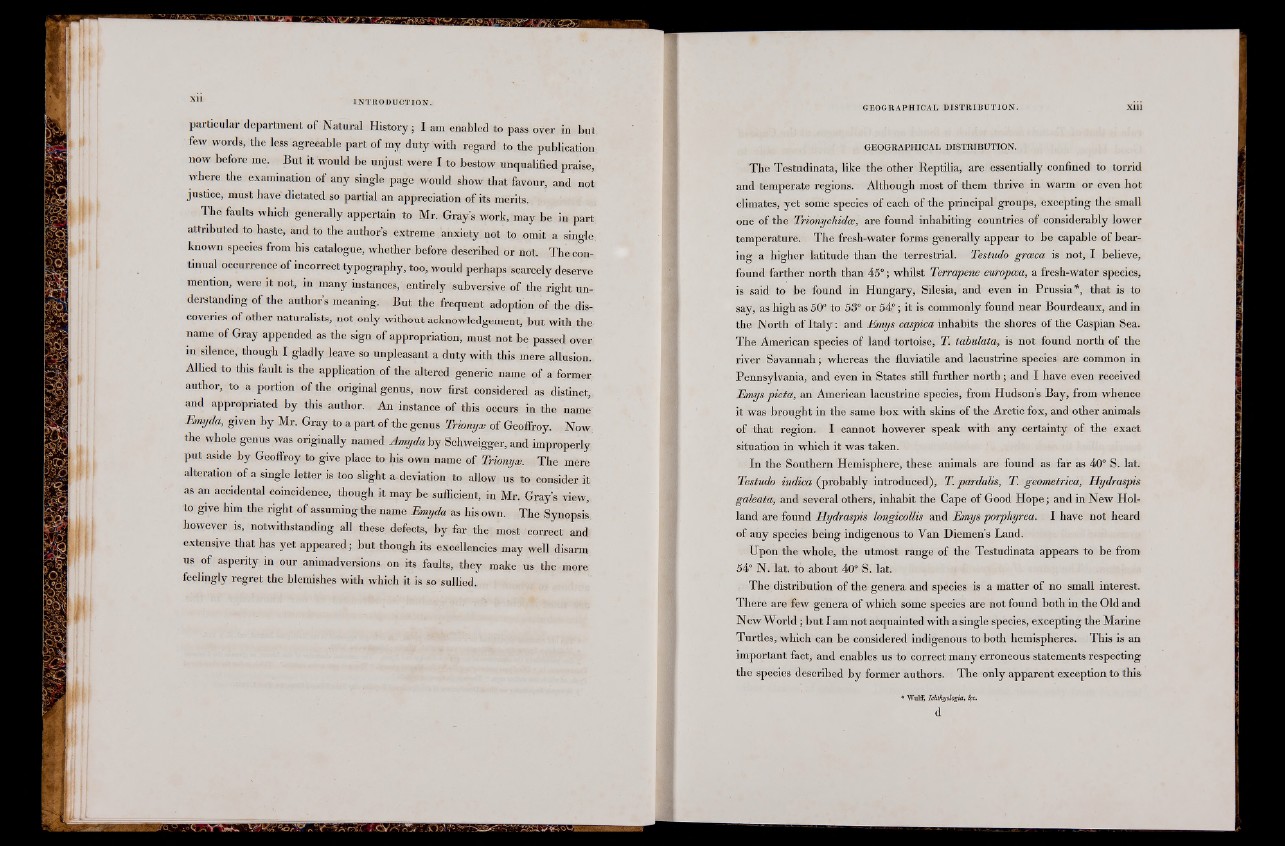
particular department of Natural History; I am enabled to pass over in but,
few words, the less agreeable part of my duty with regard to the publication
now before me. But it would be unjust were I to bestow unqualified praise,
where the examination of any single page would show that favour, and not
justice, must have dictated so partial an appreciation of its merits.
The faults which generally appertain to Mr. Gray’s work, may be in part
attributed to haste, and to the author’s extreme anxiety not to omit a single
known species from his .catalogue, whether before described or not. The continual
occurrence of incorrect typography, too, would perhaps scarcely deserve
mention, were it not, in many instances, entirely subversive of the right understanding
of the author’s meaning. But the frequent adoption of the discoveries
of other naturalists, not only without acknowledgement, but with the-
name of Gray appended as the sign of appropriation, must not be passed over
in silence, though I gladly leave so unpleasant a duty with this mere allusion.
Allied to this fault is the application of the altered generic name of a former
author, to a portion of the original genus, now first considered as distinct,
and appropriated by this author. An instance of this occurs in the name
Emyda, given by Mr. Gray to a part of the genus Trionyx of Geoffrey. Now;
the whole genus was originally named Amyda by Schweigger, and improperly
put aside by Geoffroy to give place to his own name, of Trionyx. The mere
alteration of a single letter is too slight a. deviation to allow us to consider it
as an accidental coincidence, though it may be sufficient, in Mr. Gray’s view,
to give him the right of assuming the name Emyda as his own. The Synopsis
however is, notwithstanding all these defecfis, by far the most correct and
extensive that has yet appeared; but though its excellencies may well disarm
us of asperity in our animadversions on its faults, they make vis I lie more
feelingly regret the blemishes with which it is so sullied.
GEOGRAPHICAL D I ST R IBU T IO N . XUl
GEOGRAPHICAL DISTRIBUTION.
The Testudinata, like tlm other Reptilia, are essentially confined to torrid
and temperate regions. Although most of them thrive in warm or even hot
climates, yet some species of each of the principal groups, excepting the small
one of the Trionychidce, are found inhabiting countries of considerably lower
temperature. The fresh-water forms generally appear to be capable of bearing
a higher latitude than the terrestrial. Testudo grceca is not, I believe,
found farther north than 45°; whilst Terrapene europwa, a fresh-water species,
is said to be found in Hungary, Silesia, and even in Prussia*, that is to
say, as high as 50° to 53° or 54“; it is commonly found near Bourdeaux, and in
the North of Italy: and Emys caspica inhabits the shores of the Caspian Sea.
The American species of land tortoise, T. tabulata, is not found north of the
river Savannah; whereas the fluviatile and lacustrine species are common in
Pennsylvania, and even in States still further north; and I have even received
Emys picta, an American lacustrine species, from Hudson’s Bay, from whence
it was brought in the same box with skins of the Arctic fox, and other animals
of that region. I cannot however speak with any certainty of the exact
situation in which it was taken.
In the Southern Hemisphere, these animals are found as far as 40° S. lat.
Testudo indica (probably introduced), T. pardalis, T. geometrica, Hydraspis
galeata, and several others, inhabit the Cape of Good Hope; and in New Holland
are found Hydraspis longicollis and Emys porphyrea. I have not heard
of any species being indigenous to Van Diemen’s Land.
Upon the whole, the utmost range of the Testudinata appears to be from
54“ N. lat. to about 40° S. lat.
■ The distribution of the genera and species is a matter of no small interest.
There are few genera of which some species are not found both in the Old and
N ew World; but I am not acquainted with a single species, excepting the Marine
Turtles, which can be considered indigenous to both hemispheres. This is an
important fact, and enables us to correct many erroneous statements respecting
the species described by former authors. The only apparent exception to this
* Wulff, Ichtkyologia, Sfc.
d